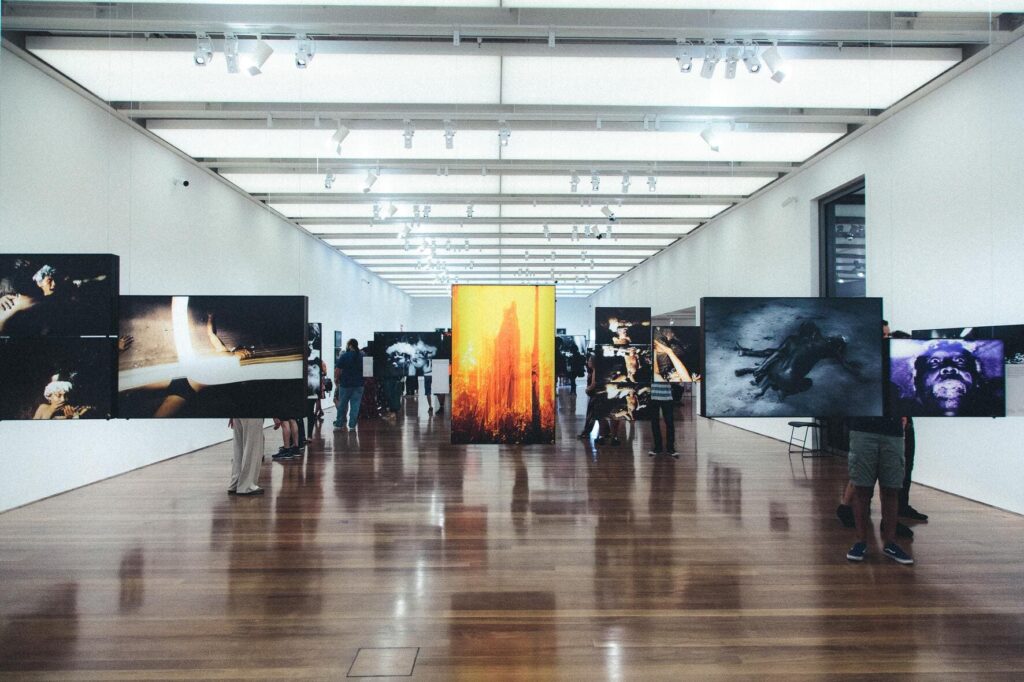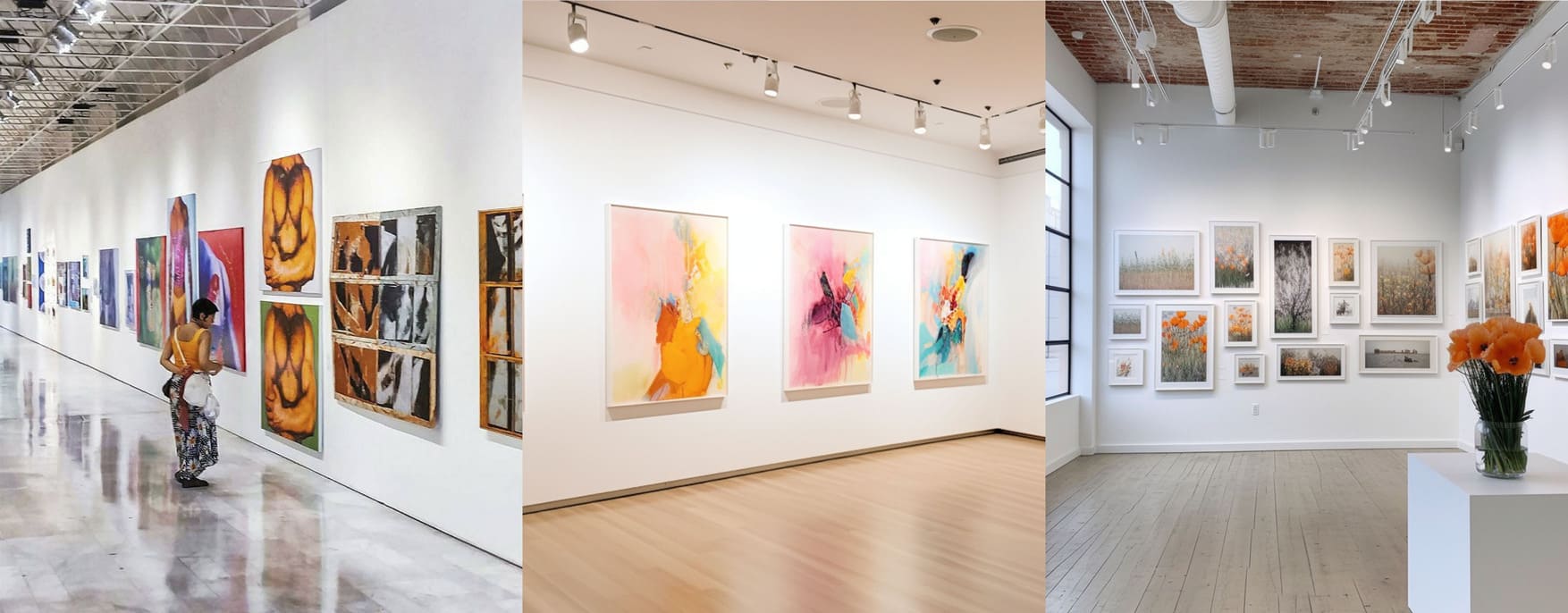Art Galleries are much more than just a physical or digital showcase space, they are a full ecosystem inside the art world. These are the places where artists exhibit their work, where they network with fellow colleagues, curators, and collectors, and where art lovers come to get in touch with art in the experiences around it.
Discover how the modern art gallery works, what’s their role inside the art community, and the latest trends for gallerists.

Contents
What is an Art Gallery
Let’s strip down the concept of what a gallery is. In its most basic form, an art gallery is a curated space where art is displayed and sold. They work directly with artists they scout and represent, as well, with the art collectors and audience interested in their work.
There are different types of art galleries but they all have this in common:
-They showcase a curated collection of artworks and artists
-Their portfolio is composed by the artists they represent
-Galleries also scout for new talents
-They showcase and sell artworks
-They are the link between artists and potential collectors or art buyers.
-Galleries take the role of promoting and marketing their current roster of artists and artworks.
-An art gallery is at its core an art business driven by the commercial dealing of art pieces.

Types of Art Galleries: same goal, different approaches
Not one art gallery is just like the other, they might have basic concepts in common, but in the art world, we can define at least a few essential types of galleries that conform to this ever-growing community.
These are just a few examples of the most visible and common types of art galleries you might find:
–Commercial Art Gallery: this type of gallery is built upon an agreement with a group of artists. The gallery takes the role of amplifying their work, representing them, opening new opportunities, and distributing their art, in exchange the gallery earns a commission for each art sale. The artist receives the seal of approval for being represented by this institution, the reputation and recognition, the guidance, and of course, the income. And is all done under the frame of a specific curatorial stand.
–Artists-Run Gallery: have you ever heard the phrase “if there is not a seat at the table, bring your own chair”? This is the epitome of that train of thought. These galleries come to be as the result of an alliance between a group of artists that decide to create a space for their work and showcase it independently. They build their own platform and art marketing strategies to put their work under the spotlight and reach their desired audience.
–Vanity Art Gallery: think of this type of gallery as a “membership” run gallery. It might or might not have a curatorial program. Usually, artists get an invitation where it is clarified that in order to be showcased or represented they have to pay a fee. Therefore, this closes opportunities for new artists or those who cannot afford this type of investment. These galleries are held by both the monetary gain of their roster of paying artists and the sale of their pieces.
–Non-profit Art Gallery: the art world usually comes together to support important causes and this is a great example of it. These types of galleries usually work thanks to funding and donations, and their goal is to generate a revenue that will be directed to a particular mission in their community.
–Mega Art Gallery: these are the evolution of commercial galleries. Not only because of the size of the collection, the number of artists they represent and how well-known they are, or even how many “in situ” spaces they have across the world. These galleries have positioned themselves as leading institutions in the art world, they are influential, define trends, launch careers, and are taken as benchmarks in the industry.
The great difference between art galleries and museums
Both museums and galleries do two similar tasks: they curate collections and they exhibit art, but there is a big difference on how they do it, why they do it, and the scope and reach of their work.
A gallery at its core is an art business, they curate exhibitions and promote experiences around it with the intention of driving sales. Museums, instead, are driven by a cultural and educational objective.
Art museums might be public or private, but are always focused on the preservation of the collections they own or that have been loaned, and showcasing their cultural value opening up access to the public. The collections they host tend to have strong historical meaning for society, and the pieces are not for sale.

The modern role of an Art Gallery
By now you must have a better understanding of what an art gallery does. They are a bridge between the artists and the collectors, they curate a selection of artists they represent and promote, and obviously, they make a profit through art sales. But how does this all happen? Let’s review each step:
Creating and curating an exhibition program
Each institution has its own requirements based on the overall message it intended to communicate as part of its brand and the pieces they want to cater to its audience.
Some galleries are invite-only, others do open calls, and others scout for the newest talent around, either way, in most cases, they are looking to develop a long-standing relationship with their artists that will translate into a sturdy art business. If the artists do well, the galleries do well.
Showcasing and selling the artist’s work is what the public sees, behind the scenes, the gallery is involved in the development of their career from general oversight of it to administrative support, marketing, representation, relationships with customers, and more.
Promoting a profitable portfolio
The portfolio of artists they represent is the greatest asset for a gallery. This is a cycle: getting representation from a gallery raises an artist’s reputation, when an artist’s reputation grows their work values does too, and the gallery gets the benefit of having in the roster a well-known artist.
The artworks from each artist are carefully selected as part of the curatorial process of the exhibitions the gallery has planned. These could be solo exhibitions (a big highlight in an artist’s career), a duo exhibition or even group exhibitions.
As mentioned before, the gallery is the link between the artists and the potential buyers, art dealers and others interested in growing their collections. This makes galleries the “primary market” for art.
Art selling: the business side of a gallery
Once the artists have been selected, the artworks have been curated into an engaging collection that takes life in a physical or digital exhibition, the gallery takes the role of an art dealer, pushing their art sales strategy to achieve their goals.
Not only does the gallery take care of the transaction itself but the preparation of the pieces, packing, transportation, tracking, and the whole process of getting the artwork to their new owner safely.
How can artists approach Art Galleries?
If you are an artist looking to start a partnership with a gallery or being represented by one, follow this checklist to see if you have the basic requirements to make a proposal or present yourself to a call for artists:
–Know your art gallery: take into account the type of artists they usually represent, and the style and mediums they tend to highlight. Try to reach out to those who fit your narrative, and talk directly to your target audience.
–Be part of the community: networking is key and for that to happen the easiest and most organic way is to actually show up! Attend other artists’ exhibitions, visit new galleries, and be a regular in the space you want to inhabit.
–Get all the requirements: galleries usually have a specific time and date for applications during the year. Make a list of those institutions where you would love to showcase your work and make sure you have your proposal, portfolio, and resume updated.
–Update your resume and CV: yes, no matter at which stage of your career you are, keep this document up to date and ready to be presented.
–Put on a twist on your portfolio: bring your pieces to life in a digital space like a Virtual Exhibition, there are creative assets to make it look as realistic as possible, plus, it gives everyone evaluating your proposal a better sense of how your art interacts with the space.
–Build social proof: being on social media and presenting your work is already a form of curation. You are taking well-thought steps to showcase your work and building a community around it. That digital following you have built gives any gallery a sense of the audience that you and your work will attract.
–Create an interesting proposal: focus on creating a strong artist’s statement, along with a full detailed description of the pieces you want to showcase and the way you intended to do it.
–Get visual aids: an image is worth a thousand words. If you are pitching your collection to a Gallery you know, take pictures of the space or look for them online. With ArtPlacer Personal Spaces, you can upload them and lay out your artworks in the real size and the intended space. The result is a real-life-looking mockup of your art “in situ” that will surely get you a callback.
Art Marketing strategies for Art Galleries
To achieve their sales goal a gallery has to build an art marketing strategy that includes the general promotion of their space and brand, the marketing of the artists they represent, and also, particular communication strategies to reach their audience and get them to visit and be part of the exhibitions they have planned.
Just like modern artists have a digital tool kit, galleries also have one to achieve these goals:
-A great opportunity for galleries is Virtual Exhibitions, these are digital spaces that are open 24/7 and accessible to any part of the world with just one click. ArtPlacer offers a variety of pre-existing exhibitions fit for every need, style, and size of collection, and also ventures into the creation of original spaces or the recreation of physical spaces, creating a hybrid experience for visitors.
-It’s all about branding: when it comes to social media a gallery’s goal is to represent their message, strengthen the visuals they are recognized for and highlight the work of the artists they represent. A feed mixing room mockups and personal spaces can create an interesting artist’s profile that gives visitors a sense of what they can experience in their future visits.
-Recreating the art sales experience: a big part of the “primary market” led by galleries now happens online. With website integrations like ArtPlacer’s galleries can offer a “try-before-you-buy” experience at the point of sale where the potential buyer can get in touch with the piece and take a look at how it will be placed in the precise space they intend to hang it on, with the help of a widget and AR technology.
Now that you know what the work of art galleries and how they do it, it’s time to get working to get your art business growing.




I am not an artist myself but I promote sculptors, clay artists, sign writers and drawers. There is too much talent and creativity around me but they lack exposure.